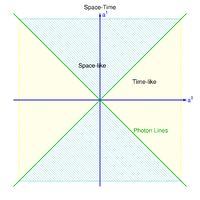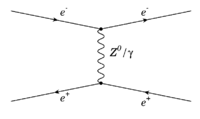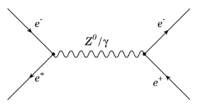Forest Bhabha Scattering
Bhabha (electron - positron) Scattering
Bhabha scattering identifies the scatterng of an electron and positron (particle and anti-particle). There are two processes that can occur
1.) scattering via the "instantaneous" exchange of a virtual photon
2.) annihilation in which the e+ and e- spend some time as a photon which then reconverts back to an e+e- pair
e+e- scattering (t-channel) (space-like)
The Feynman diagram is a space-time description of the interaction where the horizontal axis (abscissa) is used to denote time and the vertical axis (ordinate) is 3-D space.
A particle which travels only along the horizontal time axis is not moving in space while a particle traveling only along the vertical axis is not moving in time (within the uncertainty principle).
Step 1 Draw the Feynman Diagram
If the electron and positron simply scatter off of one another via a coulomb interaction, then they exchange a photon along the space axis. You start with an external line from the left to represent the electron. This is a "t-channel" process in which one of the particles emits a virtual photon that is absorbed by the other particle (the internal photon connects two vertices). You can tell the exchanged particle is virtual if it is drawn parallel to the time axis in the Feynman diagram.
- The time axis is from left to right so the Virtual particle is along the space axis (in some books the diagram has the space axis horizontal). Also note that a virtual, neutral Z-boson may also be exchanged via the electro-weak interaction.
Step 2 Label 4-Momentum
Let:
- initial electron 4-momentum
- initial electron spinor
- final electron 4-momentum
- final electron spinor
- initial positron 4-momentum
- initial positron spinor
- final positron 4-momentum
- final positron spinor
Momentum conservation at the electron vertex
Conservation of 4-momentum at the electron vertex for the e+e- scattering Feynman diagram
if
Then
- photon with mass Virtural Photon
Step 3 Matrix Element
Initial state Vertex
The electron scatters
photon propogator
where
Second Vertex
The electron scatters
Matrix amplitude
- = t-channel scattering matrix amplitude
e+e- Annihilation (s-channel) (time-like)
Step 1 Draw the Feynman diagram
If the electron and positron form an intermediate state which then decays back to an electron and positron. This is an "s-channel" process in which an intermediate state is created.
Step 2 identify 4-Momentum conservation
- Momentum conservation at the first vertex
- Unlike scattering the e- state combines with the e+ state to emit a photon which will then produce an e+e- pair some time later. So the initial 4-momentum of the two incident particles combines to form the 4-momentum of the intermediate state
Let:
- initial electron 4-momentum
- initial electron spinor
- final electron 4-momentum
- final electron spinor
- initial positron 4-momentum
- initial positron spinor
- finial positron 4-momentum
- finial positron spinor
Step 3 Matrix Element
Top Vertex
The electron scatters
photon propogator
Bottom Vertex
The electron scatters
Matrix amplitude
- = t-channel scattering matrix amplitude
Step 4 Find total amplitude
Matrix element for scattering
According to the Feynman RUles for QED:
the term
is used at the vertex to describe the Quantum electrodynamic (electromagneticc) interaction between the two fermion spinor states entering the vertex and forming a photon which will "connect" this vertex with the next one.
- The QED interaction Lagrangian is
Matrix element for annihilation
Radiative Bhabha Scattering to measure running of alpha


